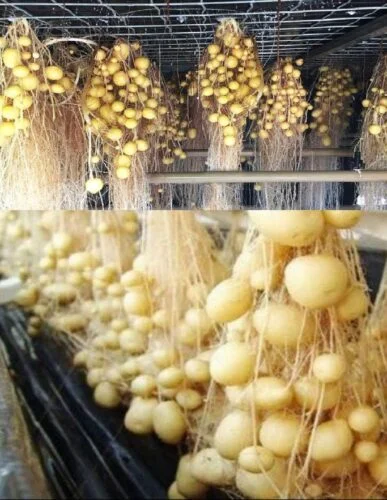Potato cultivation has always been associated with tilled land and land. However, with the advent of modern agricultural technology, innovative methods have emerged that allow farmers and hobbyists to farm in ways that were previously thought impossible. One such method is the aeroponic system. This technique allows plants, including potatoes, to be grown in the air, with their roots sprayed with nutrient-rich solutions. This article explains in depth how to grow potatoes with the aeroponic method.
1. What is aeroponics?
Aeroponics is a subset of hydroponics in which plants are suspended in the air and exposed roots are regularly sprayed with a nutrient solution. This technique offers faster growth rates, higher yields and a cleaner growing environment than traditional soil cultivation.
2. Materials needed :
- Aeroponic system : These systems are equipped with a tank, a misting system and supports for suspending plants. You can purchase a ready-made plant or create a do-it-yourself version according to your needs.
- Seed potato tubers or cuttings : Choose healthy, disease-free tubers. If you use cuttings, make sure they have “eyes” from which shoots can emerge.
- Nutrient Solution : This solution provides all the essential nutrients that potatoes need to grow. Potato-specific solutions are available, but general vegetable solutions can also be used.
- pH test kits and pH solutions : Maintaining the right pH is essential. A pH test kit and solutions to adjust the pH (up or down) will help ensure that the nutrient solution is always in the optimal range for potato growth.
- : These containers hold potato cuttings or seed tubers in place, allowing the roots to grow freely.
3. Steps to grow potatoes by air :
- Setup : Begin assembling your aeroponic system following the manufacturer’s instructions or your DIY project.
- Planting tubers : Place each tuber or potato cutting in a mesh pot. Make sure your eyes are facing up. If using cuttings, a segment with 2-3 eyes is ideal.
- Nutrient Solution : Prepare the nutrient solution according to the manufacturer’s instructions. After preparation, use the pH test kit to check the level. Potatoes thrive in a pH between 5.2 and 6.0. If necessary, adjust the pH using pH solutions.
- : The aeroponic system mists the roots at regular intervals, ensuring they receive adequate moisture and nourishment. The nebulization frequency may vary depending on the system and environmental conditions. Make sure the roots remain moist, but not waterlogged.
- Monitor growth : As potatoes grow, monitor their progress. Make sure the nutrient solution does not run out and that the pH remains stable.
- Harvest : When the plants flower and then begin to die, it is a sign that the potatoes are ready for harvest. Turn off the system and carefully remove the potatoes from the mesh pots.
4. Advantages of aeroponic potato cultivation :
- Reduced Disease Risk : With no soil to harbor pests or diseases, air-grown potatoes often have fewer problems with common potato ailments.
- Higher yield : Thanks to the optimized supply of nutrients and oxygen, potatoes can grow faster and produce more.
- Space efficiency : Aeroponic systems can be stacked vertically, making them an excellent solution for urban or space-limited environments.
- Water Efficiency : These systems use less water than traditional growing methods, making them eco-friendly.
In conclusion, although the concept of growing potatoes in the air may seem futuristic, it is a reality today. With aeroponics, we can not only optimize potato growth, but we can also do it sustainably and efficiently. As technology continues to reshape agriculture, adopting these innovative methods can pave the way for a more food-secure future.
Do you like this? Share the inspiration with your friends!
